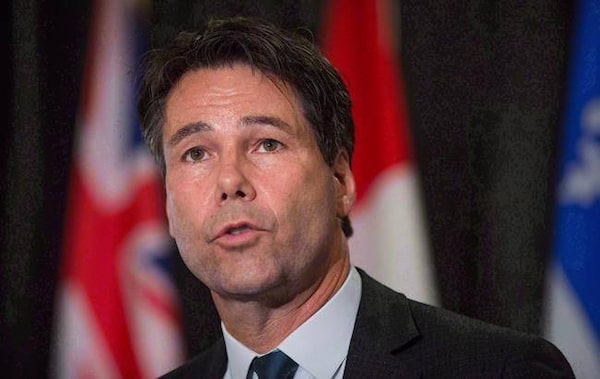
Ontario Health Minister Eric Hoskins speaks during a news conference after the first day of a meeting of provincial and territorial health ministers in Vancouver, B.C., on Jan. 20, 2016.Darryl Dyck/The Canadian Press
Toronto's Board of Health is calling on the Government of Ontario to declare a state of emergency because of a spike in overdose deaths due to opioids, however the province's Health Minister says that's the wrong tool for the job.
While a number of groups have called on Ontario in recent months to follow British Columbia's example and declare a state of emergency due to mounting overdose deaths, Health Minister Eric Hoskins says harm-reduction activists and Toronto health officials are mistaken in their belief that a state of emergency would speed the flow of funding or ease regulations around illegal pop-up supervised injection sites.
"I understand their motivation but they can't look to B.C.'s model as unlocking certain things here. They need to look at it in an Ontario context," Dr. Hoskins told The Globe and Mail on Monday. "It would not provide me with any opportunities or powers that I don't already have."
Facing a fentanyl overdose crisis that was rapidly worsening, B.C.'s provincial health officer declared a public health emergency in April, 2016. The legislation in that province gave his office sweeping powers to gather health data while requiring public health bodies to co-ordinate their efforts. Dr. Hoskins says his office already has those powers.
Unlike in B.C., Ontario's rules for a state of emergency are designed to confront a short-lived health crisis in which the general public is at risk, such as the outbreak of severe acute respiratory syndrome in 2003. The state of emergency would also be time-limited and could only be renewed once by the Health Minister for a second period of 14 days. There is a possibility the legislature could extend the emergency, but it's unclear if they could do so more than once, according to Dr. Hoskins's office.
"It doesn't lend itself to what we're trying to accomplish because this is a crisis that has been around for some time and is going to be around for a long time, regrettably," Dr. Hoskins said of the deaths from opioids.
However, city councillor Joe Cressy, a member of Toronto's board of health and chairman of the city's drug strategy implementation panel, said declaring an emergency would mean faster funding for harm prevention and "regulatory flexibility" for what are now illegal pop-up drug-use sites: "The province has to treat this more seriously than it has. They have done good work. But this is an emergency, thus they need to call it an emergency."
Eileen de Villa, the city's medical officer of health, said there were a variety of reasons an emergency declaration could help: "Funding certainly would be one. And the other would be around creating the opportunities to loosen up regulations and allow for actions that are challenging to implement in the current state."
There's nothing in the Emergency Management Act that would speed the delivery of funds, and rules surrounding supervised-consumption sites are set by the federal government, Ontario's Health Ministry said in response to Mr. Cressy's and Dr. de Villa's comments.
In a statement from his office, Toronto Mayor John Tory said he disagreed with the call for a state of emergency. "I'm not sure that a formal declaration by the province would produce any resources for us that we aren't already receiving," he said.
In addition to calling for the emergency, the Board of Health voted on a series of motions, including looking for more locations for supervised drug-use sites beyond the three planned and approved sites. Health officials were also told to study whether facilities for the safe inhalation of drugs, not just injection sites, were needed.
Toronto Public Health also released official figures from 2016, saying there were at least 124 opioid overdose deaths in the city plus another 54 deaths blamed on a combination of opioids and alcohol.
On Monday, the board heard several pleas from both drug users and harm-reduction workers associated with the volunteer-run illegal pop-up supervised injection site that has operated in Moss Park in the city's east end since August. Activists there say they have reversed more than 30 overdoses in Moss Park with the anti-overdose drug naloxone, and another 50 without it.
Zoe Dodd of the Toronto Harm Reduction Alliance, which runs the pop-up site, pointed out that many more people are dying from the opioid crisis than ever did during the SARS crisis, when a public health emergency was declared. She said it was time to stop talking and start acting.
 Justin Giovannetti
Justin Giovannetti Jeff Gray
Jeff Gray